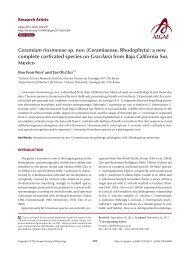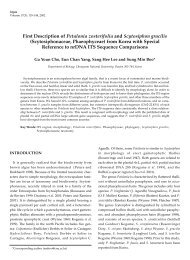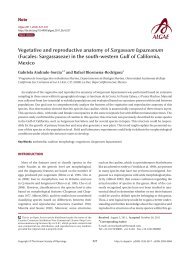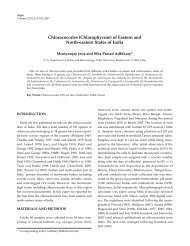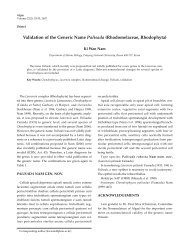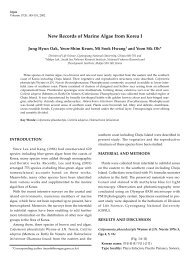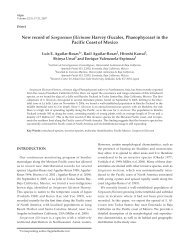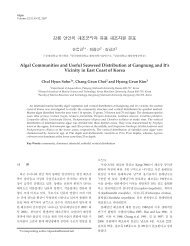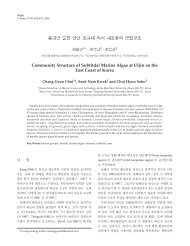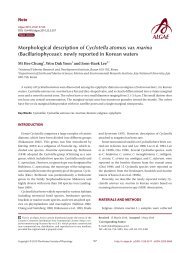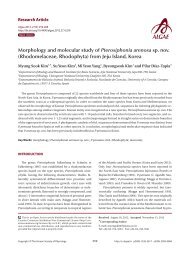Morphology and distribution of some marine diatoms, family ... - Algae
Morphology and distribution of some marine diatoms, family ... - Algae
Morphology and distribution of some marine diatoms, family ... - Algae
You also want an ePaper? Increase the reach of your titles
YUMPU automatically turns print PDFs into web optimized ePapers that Google loves.
Cells are solitary, large, bilaterally symmetrical, 108.3-<br />
190.6 μm in diameter, 413.3 μm long, elliptical in cross section,<br />
crescent shaped in lateral view <strong>and</strong> <strong>of</strong> sigmoid form<br />
in ventro-dorsal view. Valve is conoidal with a rounded or<br />
truncated apex <strong>and</strong> with longitudinal undulations. Process<br />
is a cylindrical external tube, straightened towards<br />
the distal part, merging with the calyptra structure <strong>and</strong><br />
circular pore in the distal part <strong>of</strong> the tip, 6.7-7.3 μm long,<br />
0.8-1.0 μm in diameter. Valve areolae, 13-16 in 10 μm, are<br />
arranged in regularly straight striations, with a secondary<br />
quincuncial pattern. Otaria, claspers, <strong>and</strong> contiguous areas<br />
are absent. Girdle segments are oriented in a straight<br />
line <strong>and</strong> arranged in two dorsiventral columns. Segment<br />
areolae, 17-22 in 10 μm, are arranged in regular, straight<br />
striations, with a secondary quincuncial pattern, loculate<br />
areolae, with the velum perforated by slit-like pores <strong>and</strong><br />
internal foramina, circular to subcircular. Horizontal axis<br />
<strong>and</strong> perpendicular axis <strong>of</strong> segments are 108.3-190.6 <strong>and</strong><br />
11.7-25.0 μm in length, respectively.<br />
Distribution. Neocalyptrella robusta is distributed<br />
from tropical to temperate waters (Hasle <strong>and</strong> Syvertsen<br />
1996, Hernández-Becerril <strong>and</strong> Meave del Castillo 1996).<br />
It has been reported to occur in littoral Argentinean waters<br />
(Ferrario <strong>and</strong> Galávan 1989, as Rhizosolenia robusta).<br />
During this study, N. robusta was rare but observed in<br />
September 2008 <strong>and</strong> June 2009 at Geoje Isl<strong>and</strong>, the Korea<br />
Straight, the Wolsung coast, <strong>and</strong> the Yellow Sea.<br />
Pseudosolenia calcar-avis (Schultze) Sundström<br />
1986 (Fig. 4, A-H)<br />
Schultze 1858, p. 339, Pl. 13, Figs 5-10; Peragallo 1892,<br />
p. 113, Pl. 17, Fig. 9; Hustedt 1930, p. 592, Fig. 339 as R. calcar-avis;<br />
Cupp 1943, p. 89, Fig. 51 as R. calar-avis; Navarro<br />
1981, p. 430, Figs 36 & 37 as R. calcar-avis; Sundström<br />
1986, p. 95, Figs 40-46 & 247-257; Hernández-Becerril<br />
1995, p. 254, Figs 7-10; Hasle <strong>and</strong> Syvertsen 1996, p. 160,<br />
Pl. 30; Sunesen <strong>and</strong> Sar 2007, p. 637, Figs 68-81.<br />
Synonym. Rhizosolenia calcar-avis Schultze 1858.<br />
Cells are usually solitary, elongated, <strong>of</strong> cylinder shape,<br />
bilaterally symmetrical, circular in cross section, 9.3-90.0<br />
μm in diameter, 206.7-793.8 μm long. Valve is sub-conical,<br />
asymmetrical, with the ventral part slightly longer than<br />
the dorsal part. Contiguous area is a narrow groove, sigmoid,<br />
extended from the basal part <strong>of</strong> the process to the<br />
margin in the ventral part <strong>of</strong> the valve. Process is claw or<br />
screw shaped, slightly or strongly curved, <strong>and</strong> tapered<br />
towards the distal part, 10.7-51.4 μm long. Otaria <strong>and</strong><br />
claspers are absent. Valve areolae are poroid, circular,<br />
16-34 in 10 μm. Striations are regular <strong>and</strong> straight, with<br />
Yun & Lee <strong>Morphology</strong> <strong>and</strong> Distribution <strong>of</strong> Marine Diatoms<br />
a secondary quincuncial pattern. Girdle segments are<br />
scale-shaped to rhomboidal, arranged in two or multiples<br />
<strong>of</strong> two columns, with a sub marginal seam-like structure<br />
close to the advalvar margin with entire hyaline edges.<br />
Horizontal axis <strong>and</strong> perpendicular axis <strong>of</strong> segments are<br />
9.3-90.0 <strong>and</strong> 9.3-46.2 μm long, respectively. Segmented<br />
areolae are 21-38 in 10 μm in a secondary quincuncial<br />
pattern.<br />
Distribution. Pseudosolenia calcar-avis is a circumglobally<br />
distributed species (Sundström 1986) <strong>and</strong> occurs<br />
in warm waters <strong>and</strong> occasionally in temperate waters<br />
(Hasle <strong>and</strong> Syvertsen 1996). It has been reported several<br />
times in both oceanic <strong>and</strong> near-shore waters along the<br />
coastline <strong>of</strong> Argentina (Ferrario <strong>and</strong> Galávan 1989, as<br />
Rhizosolenia calcar-avis). In the present study, this species<br />
was rarely observed in September 2008 to September<br />
2009 in the oceanic waters <strong>of</strong> Jeju Isl<strong>and</strong> <strong>and</strong> the Yellow<br />
Sea.<br />
Guinardia delicatula (Cleve) Hasle 1995<br />
(Fig. 5, A & B)<br />
Cleve 1900, p. 28, Fig. 11; Hustedt 1930, p. 577, Fig. 328;<br />
Cupp 1943, p. 83, Fig. 44; Hendey 1964, p. 147, Pl. 4, Fig. 2;<br />
Drebes 1974, p. 49, Fig. 35a; Sundström 1986, p. 103, Figs<br />
272 & 273.<br />
Basionym. Rhizosolenia delicatula Cleve 1900.<br />
Cells form fairly straight chains <strong>and</strong> are bilaterally symmetrical.<br />
Cells are 7.9-13.2 μm in diameter, 24.9-30.0 μm<br />
in length. Valve margins are round. External process is<br />
thin <strong>and</strong> short, <strong>and</strong> narrow, tube-shaped, <strong>and</strong> oblique to<br />
the pervalvar axis. External processes are 2.1-5.0 μm long.<br />
External process fits into a depression on the adjacent<br />
valve. Girdle segments are composed <strong>of</strong> open b<strong>and</strong>s, with<br />
poroid areolae, <strong>and</strong> are not noticeable. Segment horizontal<br />
axes are 7.9-13.2 μm long.<br />
Distribution. Hasle <strong>and</strong> Syvertsen (1996) reported that<br />
G. delicatula is a cosmopolitan species in temperate <strong>and</strong><br />
tropical waters. During the present study, this species was<br />
recorded in July 2009 <strong>and</strong> January 2010 in the coastal waters<br />
<strong>of</strong> Sacheon, Incheon, <strong>and</strong> Mokpo.<br />
Guinardia flaccida (Castracane) H. Peragallo 1892<br />
(Fig. 5, C-E)<br />
Castracane 1886, p. 74, Pl. 29, Fig. 4; Peragallo 1892,<br />
p. 107, Pl. 1, Figs 3-5; Bergon 1903, p. 78, Pl. 2, Figs 1-3;<br />
Hustedt 1930, p. 562, Fig. 322; Cupp 1943, p. 78, Fig. 40;<br />
Hendey 1964, p. 147, Pl. 5, Fig. 5; Drebes 1974, p. 58, Fig.<br />
43a; Hasle 1975, p. 116, Figs 64, 65 & 81-89; Navarro 1981,<br />
307 http://e-algae.kr



